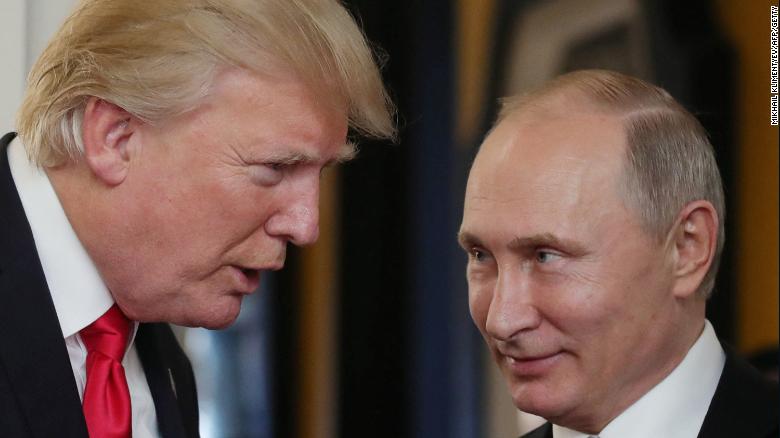
Americans rarely pay much attention to international events. Busy lives leave little time for distant events with unfamiliar protagonists.
Russian President Vladimir Putin’s invasion of Ukraine has become a rare exception, its butchery in plain view via saturation coverage for anyone with a video screen. But Americans may not yet have absorbed this disturbing reality: The American president who left office just 14 months ago sided with the butcher.
That’s right: In the struggle now uniting the free world against an autocrat’s lawless aggression, America’s most recent ex-President sided with the autocrat.
It’s not just that Donald Trump recently hailed the “genius” of Putin’s strike against Ukraine. Since his political career began, Trump has backed Putin in ways connected directly to the Russian’s quest to subjugate that country.
For years, relations between Russia and the celebrity real estate executive were lubricated by money. There was the development financing Trump’s sons boasted about, the Palm Beach mansion he sold to a Russian oligarch for $95 million four years after buying it for $41 million, the Manhattan project in association with a mob-linked Russian émigré.
He sought to place a Trump Tower in Moscow even as he ran for president. In 2013, when he staged a beauty pageant there, Trump asked on Twitter: “Will (Putin) become my new best friend?”
Putin seized Crimea from Ukraine the following year. Protests in Kyiv had forced a Kremlin ally to quit the presidency. The ousted president, who fled to Russia, had been advised by an American political consultant. That consultant, Paul Manafort, subsequently became Trump’s 2016 campaign manager.
Candidate Trump spoke forgivingly about Russia’s violation of Ukrainian sovereignty. He mused about lifting sanctions to smooth relations with Putin.
“The people of Crimea, from what I’ve heard, would rather be with Russia than where they were,” Trump told ABC News in July 2016. That had been Putin’s justification for the invasion.
President Trump sought to undo one punishment imposed on Putin by proposing that Russia rejoin the G7, an organization of the world’s major industrial economies. Other members, who had teamed with the US to kick Russia out during Barack Obama’s presidency, declined to go along.
His administration implemented some new sanctions on Russia at the insistence of national security officials and Congress. Trump himself objected.
“In almost every case, the sanctions were imposed with Trump complaining about it and saying we were being too hard,” his former national security adviser John Bolton said on Newsmax recently.
Russia menaced Ukraine throughout Trump’s term. He strengthened Putin’s hand in several ways.
Trump cast doubt on America’s decades-old commitment to defending European partners in the North Atlantic Treaty Organization. Aides feared he might try to withdraw from NATO if he won a second term.
He fomented discord at home, advancing Putin’s objective of sapping American resolve. “Donald Trump is the first president in my lifetime who does not try to unite the American people,” his former Defense Secretary James Mattis said in 2020.
Trump shielded Russia from opprobrium. Echoing Russian propaganda, he led fellow Republicans in smearing Ukraine by falsely suggesting that Kyiv rather than Moscow had interfered in the 2016 US presidential election.
“This is a fictional narrative that has been perpetrated and propagated by the Russian security services themselves,” Fiona Hill, who had directed Russia policy on Trump’s National Security Council, told a congressional impeachment inquiry in 2019.
Republicans protecting Trump cast the impeachment as Democratic partisanship. But it traced back to Trump’s alignment with Russia against its vulnerable neighbor.
Congress had voted to provide Ukraine nearly $400 million in military aid. Trump delayed sending it.
“I would like you to do us a favor,” Trump told Ukrainian President Volodymyr Zelensky in their infamous July 2019 telephone call.
The favor was for Zelensky to smear presidential rival Joe Biden by investigating him and his son, Hunter. Zelensky never complied.
Things haven’t worked out as either Trump or Putin wanted.
Trump lost his reelection bid. Biden, who defeated him, now leads the global effort to stop Putin’s aggression.
Instead of splintering under military and economic pressure, NATO and the European Union have pulled together in support of Ukraine. Within the US, the two normally brawling political parties have joined to condemn Russian savagery.
Republican senators who voted to acquit Trump of those impeachment charges applauded as Biden excoriated the Russian leader in last week’s State of the Union address. A Republican-sponsored “Putin Accountability Act” in Congress seeks to sanction, among others, the Russian oligarch who more than doubled Trump’s money on that Palm Beach mansion.
Even Trump has changed his tune. A week after praising Putin’s strategic acumen, he denounced Russia’s attack on Ukraine as “a holocaust.”
The former President remains the leading candidate for the Republican Party’s nomination in 2024. But the longer the bloodshed in Ukraine goes on, the bigger a liability Putin will become.
Trump and those around him had wanted the controversy to go away. His former Secretary of State Mike Pompeo, who listened in the notorious Trump-Zelensky call, berated a reporter who asked about Ukraine a few months later.
“Do you think Americans care about Ukraine?” Pompeo shouted at National Public Radio’s Mary Louise Kelly.
They may not have cared then. Unfortunately for Trump, they care now.
As reported by CNN
